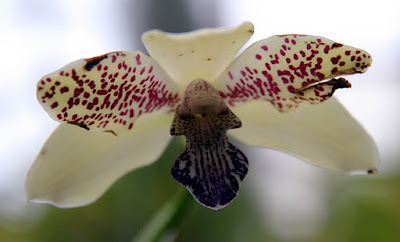Pabstia jugosa is native to Brazil. They are originally found near Petropolis, but now it is known that it occurs in many areas in the cool coastal mountains between Rio de Janeiro and Sao Paulo, usually at heights 610-1370 m...
Pabstia jugosa also called as The Saddle-Shaped Pabstia, Colax jugosus, Colax jugosus var punctatus, Colax jugosus var. rufinus, Colax viridis var. puydtii, Lycaste jugosa, Maxillaria jugosa, Pabstia jugosa var. rufina, Pabstia jugosa var. viridis, Zygopetalum jugosum, Zygopetalum stapelioides, is a species of the genus Pabstia. This species was described by Leslie Andrew Garay in 1973.
IDENTIFY PABSTIA JUGOSA
Pabstia jugosa is native to Brazil. They are originally found near Petropolis, but now it is known that it occurs in many areas in the cool coastal mountains between Rio de Janeiro and Sao Paulo, usually at heights 610-1370 m. In damp, misty habitats of rainforest most of the surface is covered with a few centimeters a layer of moss, and Pabstia jugosa grows on such mossy trees and rocks.
It is a medium sized, warm to cool growing, epiphytic or lithophytic species, which reaching the height of 20-30 cm, with clustered, narrowly ovoid to ovoid-oblong, compressed, ancipitous, somewhat sulcate, 5-8 cm long and 2-3 cm wide pseudobulbs carrying 2 apical, subcoriaceous, elongate-lanceolate, shortly acuminate, basally long-attenuate, 15-23 cm long leaves.
The Saddle-Shaped Pabstia blooms in the spring or early summer with one to four, fragrant flowers on a 22.5 cm long, erect or arching, longer than the leaves inflorescence arising as the new growth appears with oblong-lanceolate, long-acuminate floral bracts. The flowers are 5-8 cm in diameter. The outer whorls are pale, cream-white, and the inner whorls are white to cream with numerous spots or spots in deep chocolate-purple, purple-purple or pink-purple. The meaty 3-flap lip is shorter than the other elements of the flower. All three plots of the lip are also creamy-white and marked with chocolate-purple or purple-purple. There are many meaty, pubescent, radial bumps on the middle plot.
PABSTIA JUGOSA CARE AND CULTURE
Cultural information should only be used as a guide, and should be to be adapted to suit you. Your physical location; where you grow your plants, how much time you have to devote to their care, and many other factors, will need to be taken into account. Only then can you decide on the cultural methods that best suit you and your plants.
Light:
Pabstia jugosa needs a light level of 12000-18000 lux. They requires a pretty shady position. Strong air movement should be ensured all the time.
Temperature:
It is a plant with moderate thermal requirements. In summer, the average day temperature is 23-25 ° C, the night 17-18 ° C, which gives a daily difference of 7 ° C. In winter, the average day temperature is 18-19 ° C, at night 11-13 ° C, with a daily amplitude of 7-8 ° C.
Humidity:
The Saddle-Shaped Pabstia needs the humidity of 75-80% throughout the year.
Substrate, growing media and repotting:
The requirements for a large amount of water indicate that a loose, quickly draining water should be used. The addition of water-retaining materials such as perlite or cut sphagnum moss is preferred.
Pabstia jugosa are also successfully grown mounted on cork pads, but this requires maintaining high humidity, daily watering throughout the year, and during hot and dry weather, even several times. Pots should be used as small as possible, only for root maintenance, and repotting should take place every year as soon as new root growth begins.
Watering:
For most of the year, rainfall is moderate to heavy, but in winter, for 2-3 months, the conditions change a bit more dry. The substrate of the cultivated plants should be constantly moist and should never completely dry out.
Fertilizer:
The plant should be fertilized every week 1/4-1/2 of the recommended dose of fertilizer for orchids. A fertilizer with a high nitrogen content is beneficial from spring to mid-summer, and a fertilizer richer in phosphorus should be used in late summer and autumn.
To avoid the accumulation of mineral deposits during periods of strong fertilization, it is recommended to rinse the substrate every few weeks. This is especially important in places where the water is highly mineralized, because this species does not tolerate water with a high sodium content, nor the accumulation of salt in the substrate. First, normally, the plant should be watered to dissolve the accumulated salts, and after about an hour, rinse the substrate with water equal to twice the volume of the container.
Rest period:
Pabstia jugosa need less water in the winter, especially if they grow under the conditions of a dark, short day that occurs in moderate latitudes. In most cases, enough moisture will provide a fairly regular morning misting with light watering every 2 weeks, which will not allow excessive drying of the plant. Whenever the amount of water decreases, the fertilization must also be reduced or eliminated.

















COMMENTS